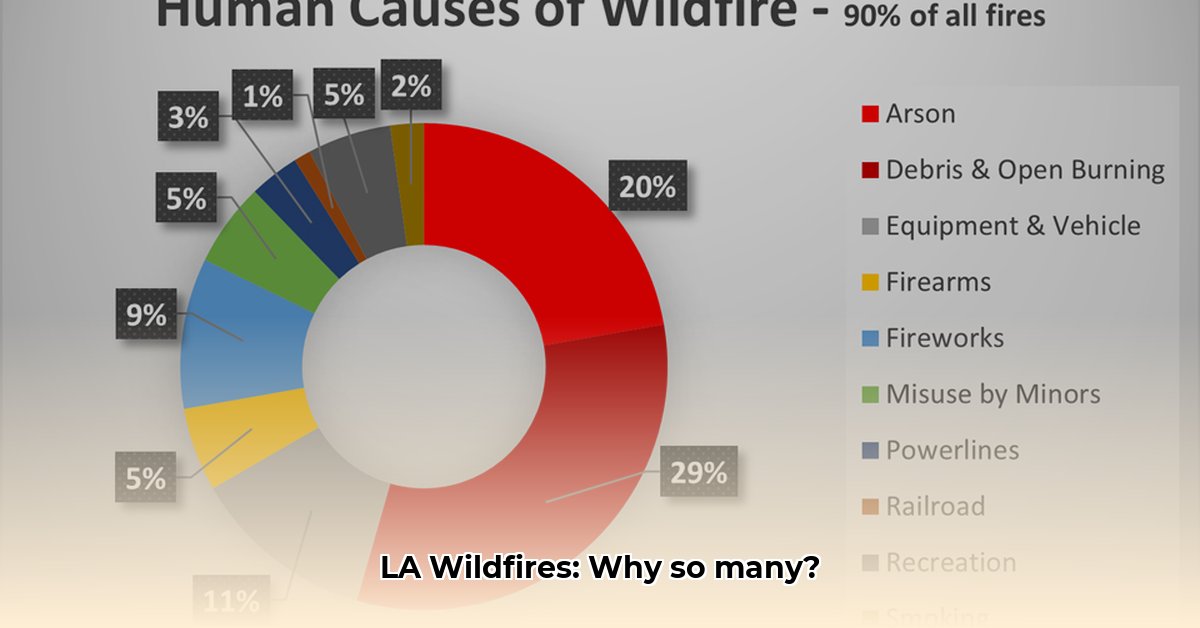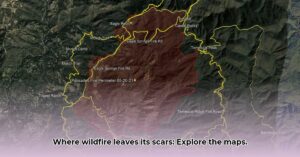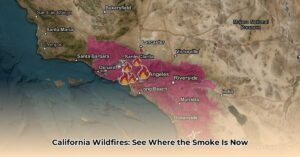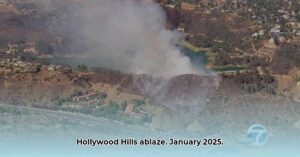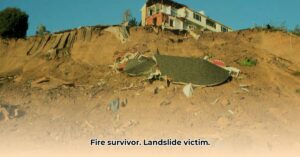Fueling the Flames: Unpacking the Causes of LA Wildfires
Los Angeles, a city renowned for its sunshine and iconic landscapes, faces a growing threat: wildfires. These devastating events are becoming increasingly frequent and intense, leaving a trail of destruction and raising a crucial question: why? The answer isn’t simple. It’s a complex interplay of natural factors, human actions, and the escalating influence of climate change. Let’s dissect the key ingredients fueling this fiery recipe.
Nature’s Tinderbox: Drought, Winds, and Chaparral
Southern California’s unique ecosystem plays a significant role in its wildfire vulnerability. The region’s characteristic chaparral—dense, drought-resistant shrubs—evolved with fire, but the intensity and frequency of modern blazes are pushing this adaptation to its limits. Prolonged droughts, intensified by climate change, desiccate this vegetation, turning it into highly flammable fuel. Then come the Santa Ana winds. These fierce, dry gusts descend from the mountains, further dehydrating the landscape and whipping any spark into a raging inferno. These “devil winds” can propel embers miles ahead of the fire front, creating new spot fires and making containment a nightmare. While lightning strikes can also ignite fires, they are less common in Southern California than in other parts of the US.
The Human Spark: Accidental and Intentional Ignitions
While nature provides the tinder, human actions often provide the spark. The causes can be accidental: a downed power line, sparks from machinery, a carelessly discarded cigarette, or even a catalytic converter’s heat igniting dry grass. Unfortunately, arson also plays a role, with intentionally set fires responsible for some of California’s most devastating wildfires. The wildland-urban interface—where homes meet wilderness—further complicates matters. As development pushes into fire-prone areas, the risk of ignition increases, and the potential for catastrophic losses grows. This encroachment into wildlands creates a dangerous proximity between human activity and highly flammable vegetation, providing ample fuel for wildfires to explode and spread rapidly.
A Changing Climate: Turning Up the Heat
Climate change acts as a threat multiplier, exacerbating existing risks. Rising temperatures create a hotter, drier environment, extending the fire season and increasing the flammability of vegetation. This creates a perfect storm for wildfire risk. These conditions are becoming increasingly common in California and other fire-prone regions, and experts predict this trend will likely worsen in the years to come. Some scientists suggest that climate change may also be influencing the frequency and intensity of Santa Ana wind events, though this is still an area of ongoing research. Longer, more intense droughts coupled with extreme heat create unprecedented fire conditions. Essentially, climate change loads the dice, making wildfires more likely, larger, and more destructive.
The Intertwined Factors: How Wind, Terrain, and Drought Converge
Understanding the complex relationship between Santa Ana winds, topography, and drought is crucial to grasping the full picture of LA’s wildfire risk. These factors don’t act in isolation; they interact in dangerous ways to create a landscape primed for ignition.
The Santa Ana winds, originating in the high deserts, become superheated and intensely dry as they are funneled through mountain passes and canyons towards the coast. This compressional heating, combined with the naturally low humidity of the desert air, creates extremely dry conditions that wick moisture from vegetation, turning it into tinder. The steep slopes and canyons of the LA area not only channel these winds, increasing their velocity, but also preheat the vegetation uphill, making it even more susceptible to ignition.
Drought, often exacerbated by climate change, further intensifies this situation. Extended periods of low rainfall dry out vegetation, creating an abundance of readily available fuel. This “fuel loading,” coupled with the dry, gusty Santa Ana winds and the channeling effect of the topography, creates a perfect storm for wildfire ignition and rapid spread. Even a small spark can quickly escalate into a raging inferno under these conditions.
Human actions, both accidental and intentional, often provide the ignition source. A carelessly discarded cigarette, sparks from equipment, or a downed power line can have catastrophic consequences in this volatile environment. Arson, the deliberate setting of fires, also contributes significantly to the problem.
Climate Change: A Looming Threat Multiplier
The already precarious wildfire situation in Los Angeles is further complicated by the looming shadow of climate change. While not a direct cause of wildfires, climate change acts as a threat multiplier, exacerbating existing risks and increasing the likelihood of more frequent and intense fires.
Rising global temperatures are driving increased evaporation, further drying out vegetation and extending the length of the fire season. This creates a longer window of vulnerability when dry, flammable landscapes are exposed to potential ignition sources. Some researchers suggest that climate change might even be influencing the behavior of the Santa Ana winds, potentially making them stronger and more frequent, although this is still an area of active investigation. The combination of these factors—drought, dry vegetation, Santa Ana winds—creates a tinderbox primed for ignition.
Climate change also contributes to a phenomenon known as “hydroclimate whiplash,” where periods of intense rainfall are followed by extended periods of extreme dryness. This boom-and-bust cycle can lead to abundant vegetation growth during wet periods, followed by rapid drying and die-off, which creates even more fuel for wildfires. The resulting increase in fuel load, coupled with the other climate-driven factors, significantly amplifies wildfire risk.
The implications of these trends are alarming. As climate change continues to unfold, the frequency and intensity of wildfires in Los Angeles are projected to increase, posing a growing threat to communities, ecosystems, and air quality. The potential for larger, more destructive megafires, capable of burning for weeks or even months, is a growing concern. Recognizing the critical role of climate change in this crisis is essential for developing effective mitigation strategies.
Mitigating the Risk: A Path Forward
Facing the increasing threat of wildfires requires a multi-pronged approach that addresses both the immediate causes and the underlying factors that contribute to the problem.
-
Improved Land Management: Implementing proactive vegetation management strategies, such as controlled burns and targeted brush clearing, can help reduce fuel loads and create firebreaks to slow or stop the spread of flames.
-
Strengthened Infrastructure: Upgrading power grids and implementing stricter building codes in fire-prone areas, utilizing fire-resistant materials and landscaping, can help protect homes and communities.
-
Enhanced Early Warning Systems: Investing in advanced fire detection technologies and early warning systems can provide critical time for evacuations and fire suppression efforts.
-
Community Education and Engagement: Increasing public awareness about fire safety, including responsible behavior during high-risk periods and creating defensible space around homes, is essential.
-
Addressing Climate Change: Tackling the root causes of climate change through reducing greenhouse gas emissions is crucial for mitigating the long-term risks of wildfires. This requires a global effort to transition to a cleaner energy future.
| Factor Category | Specific Cause | Description |
|---|---|---|
| Natural Causes | Drought | Extended periods of low rainfall create dry, easily ignited vegetation. |
| Santa Ana Winds | Strong, dry downslope winds exacerbate fire conditions by rapidly drying vegetation and spreading flames. | |
| Lightning | Although less common than other ignition sources, lightning strikes can ignite dry vegetation. | |
| Human Causes | Downed Power Lines | Faulty or damaged power lines can spark fires, especially in dry, windy conditions. |
| Arson | Intentional acts of fire-setting. | |
| Discarded Cigarettes | Carelessly discarded cigarettes can ignite dry vegetation. | |
| Sparks from Equipment | Sparks from machinery, vehicles, or construction activities can ignite dry brush. | |
| Escaped Prescribed Burns | Controlled burns intended to reduce fuel loads can sometimes escape containment and become wildfires. | |
| Climate Change | Rising Temperatures | Increased temperatures exacerbate drought conditions and lengthen the fire season. |
| Changing Weather Patterns | Some research suggests climate change might be influencing the behavior of the Santa Ana winds, potentially making them stronger or more frequent. | |
| Urban Development | Wildland-Urban Interface | Development in areas bordering wildlands increases the risk of fires igniting and spreading to homes and infrastructure. It also increases the likelihood of human activities causing fires. |
There is no single solution to the complex challenge of wildfires in Los Angeles. A comprehensive strategy that involves scientific research, proactive land management, community engagement, and a commitment to addressing climate change is essential for protecting lives, property, and the unique natural environment of Southern California. The future depends on it.

